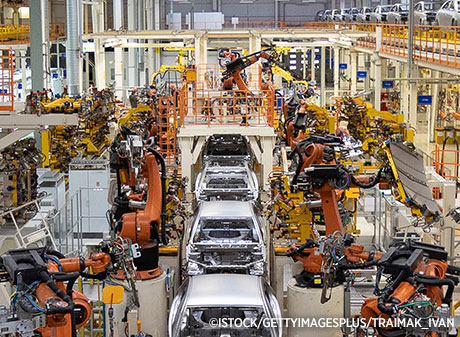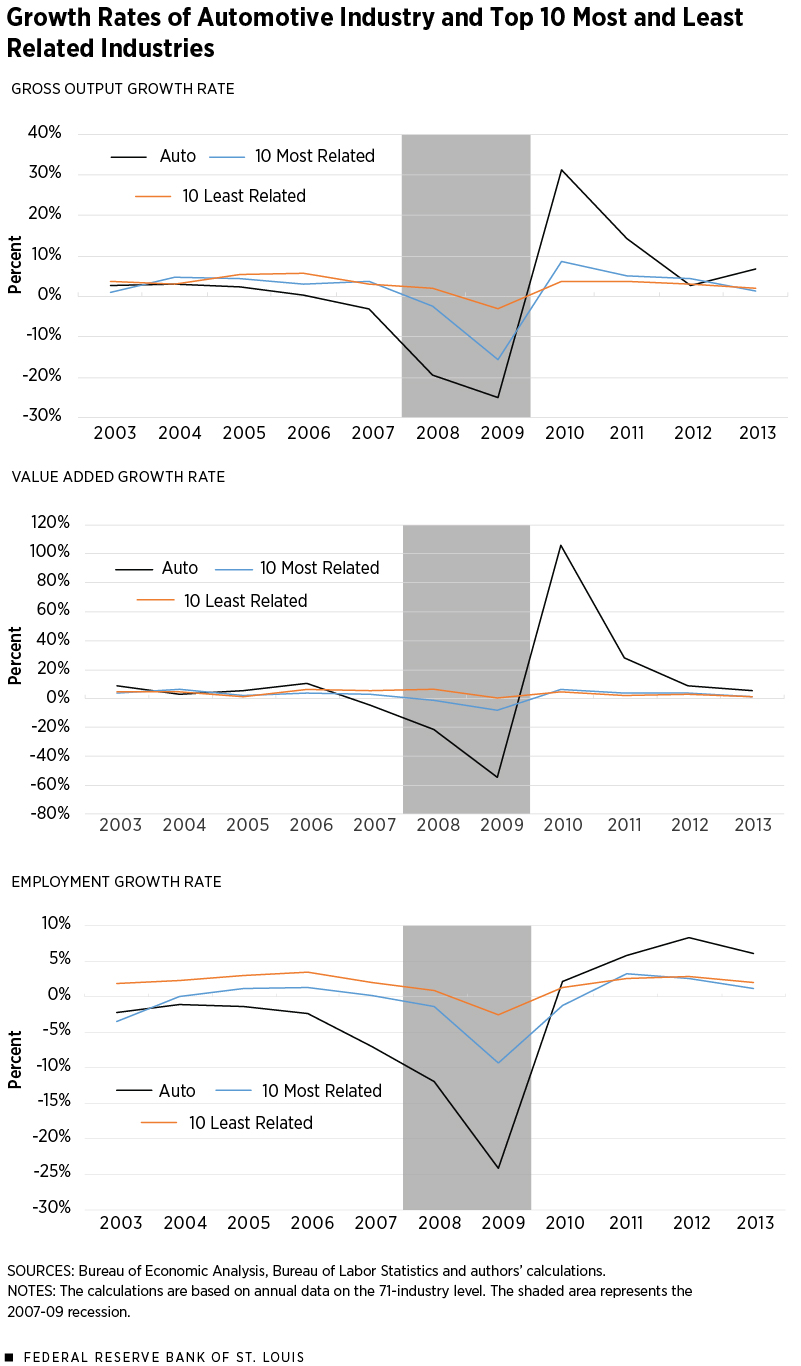The Ties That Bind: The Auto Industry and the U.S. Economy

The U.S. government’s bailout of the auto industry during the Great Recession reflected a deep concern that a crisis in this single industry would quickly spread to its suppliers and other industries. A recent article in the Regional Economist explored how industries are linked to each other through production networks.
Economist Sungki Hong, Senior Research Associate Hannah G. Shell and Research Associate Qiuhan Sun analyzed input-output tables and other data to measure the independence and interdependence of U.S. industries in the production of their goods and services.
They found that examining industry linkages within a production network is crucial for understanding industry dynamics.
“As industries are increasingly dependent on each other, their output growth and employment growth are increasingly correlated,” they wrote. “This dependency is true for both input and output relationships.”
Production Networks
As manufacturing grows more sophisticated, industries become more interconnected through production networks. For example, the auto industry takes various products from other industries—including the glass, electronic equipment and steel industries—then assembles the products together to produce a finished vehicle.
“As a result of these production networks, an economic downturn in one industry (referred to as an industry-specific shock) will be felt by all its industry partners,” the authors wrote. “New research on production networks suggests industry-specific shocks actually account for at least half of the volatility in aggregate growth.”
To study how closely related industries are to each other, the authors analyzed input-output data for 71 industries, ranging from oil and gas extraction to fabricated metals. They looked at industries that are considered downstream (those that buy material inputs to produce goods) and industries that are considered upstream (those that sell material inputs that other industries use).
“Fewer industries stand out as predominant buyers than those that stand out as predominant suppliers,” the authors wrote. “The industries that stand out as large buyers are construction, motor vehicles (auto industry), other services and government.”
The authors then measured an industry’s degree of integration with the rest of the economy by examining two measures.
- “In-degree” is the ratio of an industry’s total material costs over total final output or revenue. A high in-degree value implies that the industry is more dependent on using intermediate inputs for production.
- “Out-degree” is calculated by taking the output share of downstream purchasers’ material inputs that come from a supplier of their intermediate inputs, and then taking the sum over all the downstream industries. A higher out-degree value means an industry has many downstream purchasers that are highly dependent on the material inputs that it produces.
When examining the in-degree values among these 71 industries, the authors found that the apparel, leather and allied products industry has the highest in-degree value, at 0.75, followed by the motor vehicles, bodies and trailers, and parts industry, i.e., the auto industry.
Meanwhile, they noted that “the auto industry doesn’t have a large out-degree relative to the rest of the economy, likely because most of the industry’s finished products go directly to consumers.”
Hong, Shell and Sun also looked at how industries perform relative to each other. They looked at the growth rates of three variables of industry dynamics: gross output, value added (the difference between gross output and the cost of purchased intermediate inputs) and employment growth rates.
In their analysis of the correlation of these three variables between different industries, they found “that the correlation between industries’ output and employment growth increases as the linkage between industries becomes stronger. This pattern follows our observation that economic activity of one industry likely passes through to its related industries.”
The Auto Industry
The importance of the U.S. auto industry took center stage during the Great Recession, from 2007 to 2009, when policymakers had to decide whether to bail out the industry.
High fuel costs, a product concentration on gas-guzzling SUVs and the onset of the recession left U.S. automakers Chrysler and General Motors tottering on the brink of bankruptcy, according to the authors.
Though the third U.S. automaker, Ford, didn’t need a bailout, the company supported a government bailout of its competitors, citing the disruptive effects a bankruptcy would have on parts suppliers that Ford shared with GM and Chrysler.
During the Great Recession, terms like “too big to fail” were used to describe the phenomenon of these large, interconnected firms, the authors noted.
“A firm that is too big to fail is one that is a key hub to the U.S. production network,” they wrote. “Its failure would be felt throughout the economy.”
How did the auto industry’s woes during the Great Recession affect other industries? The figure below looks at the growth rates of three factors—gross economic output, value added and employment—in the auto industry and compares them with the growth rates of 10 industries that were most related to the auto industry and those rates of 10 industries that were least related to the auto industry.

The auto industry dropped sharply during the Great Recession and rebounded immediately following the economy’s downturn.
The auto industry’s top 10 suppliers also sustained a sharp drop followed by a resurgence in gross output and employment growth; for value added, the pattern is similar but slightly softer.
In contrast, industries that are least related to the auto industry didn’t share the same degree of movement.
The figure highlights the importance of the network structure of the U.S. economy, the authors noted.
“The auto industry is a central hub for many upstream suppliers, and any shock to the auto industry will be felt far beyond the industry itself,” they wrote. “However, industries that are relatively isolated from the auto industry won’t experience as much turmoil.”
Additional Resources
- Regional Economist: How Important Are Production Networks to the U.S. Economy?
- On the Economy: Did NAFTA Shift Car Making to Other Countries?
- On the Economy: Putting the GM Job Cuts into Broader Perspective
Citation
ldquoThe Ties That Bind: The Auto Industry and the U.S. Economy,rdquo St. Louis Fed On the Economy, April 1, 2019.
This blog offers commentary, analysis and data from our economists and experts. Views expressed are not necessarily those of the St. Louis Fed or Federal Reserve System.
Email Us
All other blog-related questions

